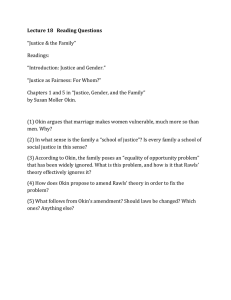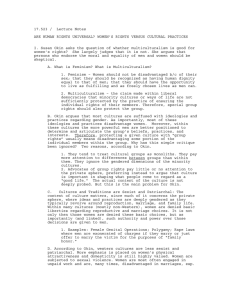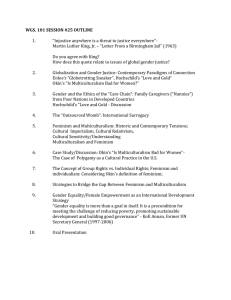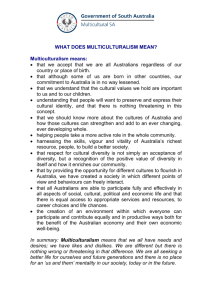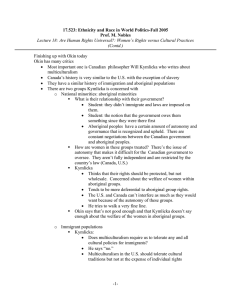17.523: Ethnicity and Race in World Politics-Fall 2005 Prof. M. Nobles
advertisement
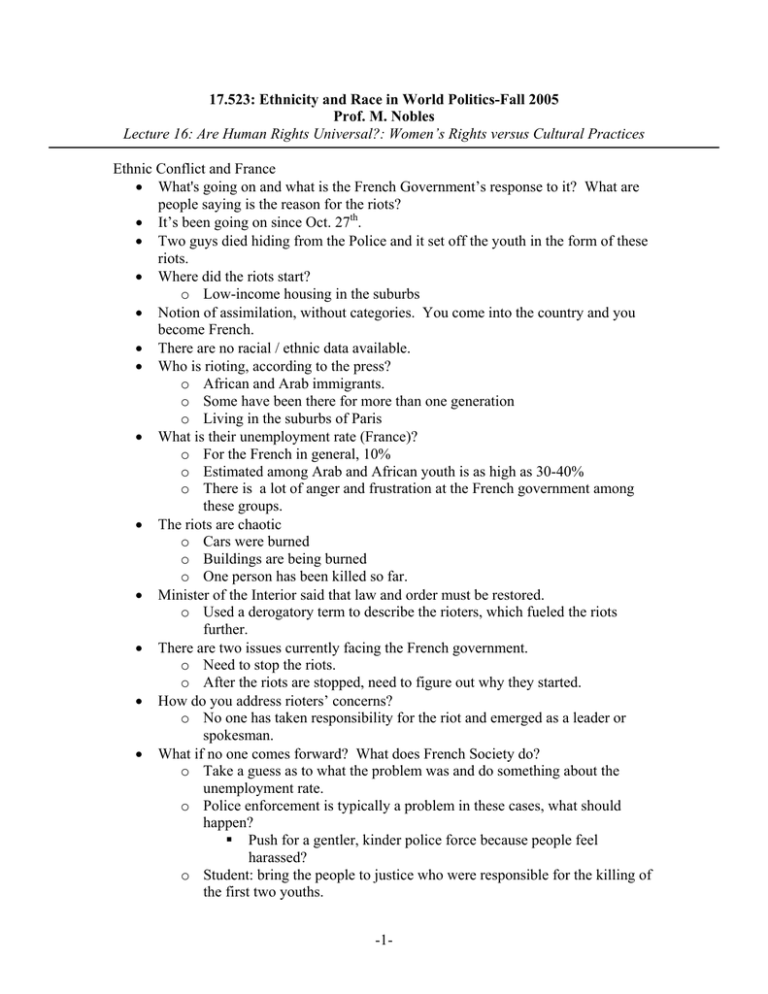
17.523: Ethnicity and Race in World Politics-Fall 2005 Prof. M. Nobles Lecture 16: Are Human Rights Universal?: Women’s Rights versus Cultural Practices Ethnic Conflict and France • What's going on and what is the French Government’s response to it? What are people saying is the reason for the riots? • It’s been going on since Oct. 27th. • Two guys died hiding from the Police and it set off the youth in the form of these riots. • Where did the riots start? o Low-income housing in the suburbs • Notion of assimilation, without categories. You come into the country and you become French. • There are no racial / ethnic data available. • Who is rioting, according to the press? o African and Arab immigrants. o Some have been there for more than one generation o Living in the suburbs of Paris • What is their unemployment rate (France)? o For the French in general, 10% o Estimated among Arab and African youth is as high as 30-40% o There is a lot of anger and frustration at the French government among these groups. • The riots are chaotic o Cars were burned o Buildings are being burned o One person has been killed so far. • Minister of the Interior said that law and order must be restored. o Used a derogatory term to describe the rioters, which fueled the riots further. • There are two issues currently facing the French government. o Need to stop the riots. o After the riots are stopped, need to figure out why they started. • How do you address rioters’ concerns? o No one has taken responsibility for the riot and emerged as a leader or spokesman. • What if no one comes forward? What does French Society do? o Take a guess as to what the problem was and do something about the unemployment rate. o Police enforcement is typically a problem in these cases, what should happen? Push for a gentler, kinder police force because people feel harassed? o Student: bring the people to justice who were responsible for the killing of the first two youths. -1- • What might France do about unemployment? Africans and Arabs don’t feel like they belong in France? o French are perplexed because of the assimilation policies. o Student: French government should do a better job of welcoming different cultures. o Student: start some notion of affirmative action. o Student: use a census to actually see what the nation is composed of to use a racial/ethnic component. • Chirac said that law and order must be restored. • Students should continue to follow this issue. It isn’t going to go away easily or quickly. • Most directly, this relates to our readings about Turks in Germany • Sheds light on the issue of Western Europe’s attitude towards immigrants and the rights of immigrants. • Most of these immigrants speak French because their home countries were colonized by France. • When they come to France, immigrants hope for an easy assimilation, but things aren’t right and they are subject to a certain amount of racism. Is multiculturalism bad for women? • How do liberal societies deal with policies that conflict with the values of the host country? • The book “Is Multiculturalism Bad for Women?” has an essay by the author Suan Okin and then responses by various authors. o How much should we respect other cultures? o How much we should respect them should be influenced .by the way the cultures treat women. o For her, people who endorse the moral equality of men and women should be skeptical of multicultural politics What is Feminism? • Student: people who advocate equal rights across gender. • Student: wasn’t it started to get equal rights as in pay? • Student: breaking down stereotypes of the assigned roles of genders. • Student: reproductive rights, contraception • Student: women shouldn’t be disadvantaged by their sex and should enjoy the same dignity as men. • P. 10 of the book. • The definition doesn’t address just the labor market or family - this equality should span all activities • Has a moral dimension as well. o That you are accorded the same amount of dignity as men. What is multiculturalism? • The claim that minority cultures/ways of life aren’t sufficiently protected by individual rights and that there should be group rights. -2- • I.e.: Canada’s relationship with its indigenous populations gives them a certain amount of autonomy. The state says that its citizens must protect the norms of these particular cultures. Okin is worried about this idea. Most cultures are suffused with ideologies of gender. What ideology does she have in mind? What are “American” cultural ideas about women? • Traditional gender roles • Student: it depends on the time period. The traditional gender roles are being challenged now. • We now have an ideology of gender equality. • Student: If you looked at America in the 1950s, women were enshrined with particular aspects of culture. Post WWII period. • But during the 60s, the women’s movement began. • Ideologies and cultural norms can change. The U.S. is an example. • Cultural changes are also due to larger structural forces. • There isn’t one factor that can explain changes in ideology, culture, etc. • Okin: Most ideologies disadvantage women. o Equality may be preached and not practiced o Sexism exists in many cultures o She’s concerned with cultures that very obviously disadvantage women. Idea of Multiculturalism and the State: According to Okin, the more powerful people within a given cultural group are men. • If the country honors these cultural practices, who is speaking for these groups? Okin says it’s the men because they traditionally have the more powerful roles. • If the host country sees itself as protecting the culture, it is ignoring an entire segment of that population. • It’s not enough to say that the country is protecting groups’ rights; you need to question the rights that you’re protecting. If women are being disadvantaged, maybe it ought not be protected. • By virtue of immigrating, you recognize that you will be playing by the rules of the host country. This point is implied by the author. • Where the state is concerned, Okin sees the greatest concern in accommodating multiculturalism is what it means for the rights of women within that group. Example: Somali immigration to Italy. Gender mutilation in Somalia is an initiation rite for girls going through puberty. It is performed in Italy, sometimes dangerously, on immigrant Somalis. • It is done in homes, and the girls often times must go to the hospital • The doctors must decide what to do: Most often they treat the girl and punish the parents (i.e. report them to the authorities). • The Italian authorities could decide: We recognize that this is a tradition, it was done poorly, but we aren’t going to punish you for doing it poorly. • Student: there need to be laws that say that medical procedures must be done in the hospital to prevent poorly done procedures. -3- • Student: you run into issues of consent when it goes into the hospital. Take for instance circumcision. • Female circumcision is often done to try and ensure the virginity of the girl. • It depends on the extensiveness of the procedure as to whether female circumcision is painful for the girl, although most often it is quite painful. • In general, male circumcision is less extensive than female circumcision. • Student: The foundations are different. Male is based on tradition. Female is based on the notion that women aren’t capable of maintaining fidelity/virginity until marriage. • There was a compromise suggested by a Somali Doctor living in Italy. o He wanted to decrease the number of injuries to young girls o For the short term, the practice isn’t going to change. o Italian state could allow the girls to come to his office, procedure, where he would perform a cutting procedure and preserve the genitalia. (It is not the traditional procedure, but it would satisfy the parents.) o There isn’t a resolution at this point. What does the host state do when they are trying to be culturally sensitive and protect women’s rights? -4-
